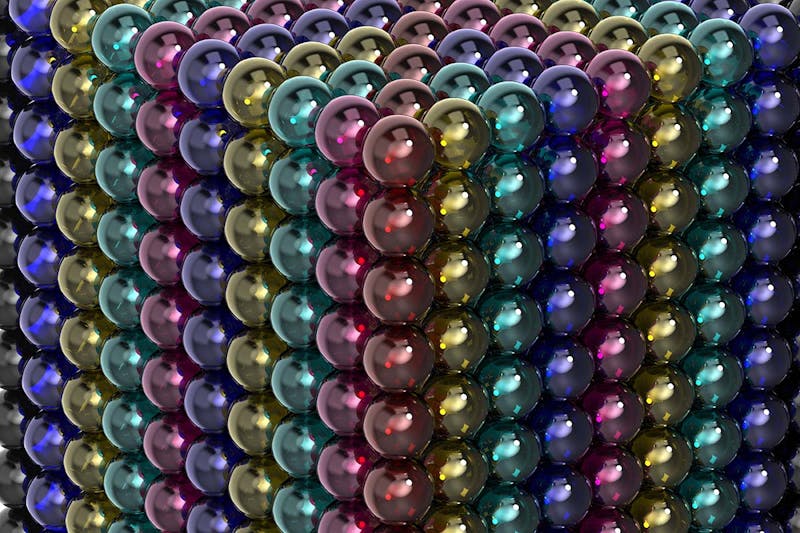
They look completely innocent. Tiny, colorful magnetic balls that can be molded into designs and shapes with no artistic limits, other than the boundaries of one’s imagination. The packaging says they are not for children under age 14, but they are easily found online with a simple Google search of “children’s magnetic toys.” YouTube videos show smiling kids exploring all the creative possibilities.
These magnetic balls, which look a lot like candy, are rare-earth magnets. They are often 10 times stronger than ordinary magnets, such as refrigerator magnets. Manufacturers put these magnets into the market under the guise of selling them for adults ― as sculptures, stress relievers and desk toys ― when they fully know that their products appeal to kids and are used by them.
The problem: When a child swallows more than one rare-earth magnet, their powerful magnetic attraction causes them to rip through internal organs to join together. The injuries often require surgery and can be life-threatening. The Consumer Product Safety Commission (CPSC) estimates that 2,900 children were treated in emergency rooms for swallowing magnets from 2009 to 2013. One study found that the mean age of children injured from ingesting rare-earth magnets is 6.4 years, with peaks at 2 to 4 years and 8 to 10 years. According to the study, all injuries to children over age 12 involved girls, who typically use the magnets to simulate tongue, lip and nose piercings.
Other causes for ingestion of rare-earth magnets include:
- Mistaking the magnets for candy
- Using teeth to separate the magnets or carrying them in the mouth
- Older children intentionally consuming the magnets, such as on a dare or to see what happens
- Consumption by children with developmental delays, who tend to put things in their mouth
Because rare earth magnets are sold in packages containing hundreds of BB-sized balls, it is easy for a child to swallow them without a parent even noticing. One study examined 72 cases of rare-earth magnet ingestion injuries among children ages 15 and younger where the number of magnets ingested in each case ranged from one to, astoundingly, 40.
If Rare-Earth Magnetic Sets Are Dangerous, Why Are They Still on the Market?
The story of how this quirky product, that many will argue society doesn’t need, remains on the market when it poses a clear and grave risk to children is a tortuous tale of the many roadblocks that the CPSC encounters when it tries to do its job of protecting the public.
Toy magnetic construction sets, designed for kids, caught the CPSC’s attention in 2005 when reports emerged of children becoming severely injured from swallowing the magnetic pieces. The issue led to the creation of a voluntary safety standard in 2007 that restricted the power of loose magnets in toys and required high-powered magnets to be permanently connected to prevent ingestion.
In 2009, rare-earth magnetic sets became a new product sensation. These magnetic sets were not covered by the voluntary safety standard for magnetic toys because they were marketed to adults, rather than children. That year, the CPSC required manufacturers of products containing these powerful magnets to be labeled for ages 14 and older.
Unfortunately, serious injuries continued notwithstanding the age-labeling, and in 2011, the CPSC began issuing public warnings of the “hidden hazard” associated with these magnets. As rare-earth magnets continued to find their way into children’s hands and mouths, the CPSC in 2012 negotiated agreements with 10 leading industry players to cease importation and distribution of the magnet sets. The agency then initiated administrative complaints against three companies that refused to cave, asking a judge to force a recall. Two of them subsequently entered into settlement agreements to stop selling rare-earth magnet sets and to recall their products. Zen Magnets persisted and was the last company standing.
The CPSC continued to forge ahead. In October 2014, it passed regulations that essentially banned rare-earth magnet sets. Zen Magnets responded by seeking review of the new safety standard by the U.S. Court of Appeals for the 10th Circuit.
Then something unthinkable to child safety advocates happened: Zen Magnets achieved stunning victories on both legal fronts.
First, in March 2016, the administrative law judge in the CPSC’s mandatory recall lawsuit ruled in favor of Zen Magnets. Eight months later, in November 2016, the U.S. Court of Appeals for the 10th Circuit overturned the CPSC’s regulation that served as a ban on the sale of rare-earth magnets.
The powerful magnets were officially back in the marketplace, once again under the guise of being sold to adults, while in fact they were used by children. The injuries came back too. Near the end of 2019, the nation’s poison control centers reported six times more magnetic ingestions ― about 1,600 ― compared with about 260 ingestions in 2016, just as the ban was lifted. Even worse, poison control calls do not capture all such incidents.
Most recently, the CPSC seems to have started over in its efforts to keep children safe from rare-earth magnets. On May 7, 2020, the CPSC issued a joint recall with importer Sobeauty for “Mag Cube” magnetic ball sets labeled as “3D MAGNETIC PUZZLE”, “MAGCUBE BUCKYBALLS” and “JOYNOTE” with “MAG CUBE” on the back of the box. According to the recall notice, the sets, which are labeled for ages 14 and older, violate the federal standard for children’s toys.
The notice states that when two or more of the high-power magnets are swallowed, “they can link together inside a child’s intestines and clamp onto body tissues, causing intestinal obstructions, perforations, sepsis and death.” The magnets were sold online at Walmart.com from March 2018 through December 2019 for between $13 and $20.
What Are the Symptoms If My Child Swallows Magnets?
According to the American College of Medical Toxicology (ACMT), a child who swallows magnets may experience no symptoms for a day or two. When the child’s bowel becomes blocked, the symptoms may be flu-like with nausea, vomiting and abdominal pain. If left untreated and the bowel wall tears, the child’s symptoms may worsen to include loss of consciousness and severe shock. Deaths have occurred as a result of swallowing magnets.
What Should I Do If My Child Has Swallowed Magnets?
ACMT recommends taking a child to a healthcare facility or calling your poison control center if your child has swallowed a magnet or one has become stuck in your child’s nose or ear. You should not try to induce vomiting or give food or drink. Call 911 if the child is experiencing difficulty breathing.
Should I Contact an Attorney If My Child Is Injured from Swallowing Magnets?
Alan M. Feldman, a co-founding partner and product liability attorney at Feldman Shepherd, recommends contacting a product liability attorney as soon as possible if your child has been injured from swallowing magnets.
Feldman said that companies that label rare-earth magnet sets as “adult” products while fully knowing that they appeal to kids and are used by them are not absolved of legal liability when children inevitably get hurt. Feldman stated that “manufacturers should not be able to hide behind age designations that do not reflect who is actually using a product. All products should be safe for their intended, as well as expected, use.”
Feldman’s team at Feldman Shepherd, which includes partners Daniel J. Mann and Edward S. Goldis, have secured substantial recoveries on behalf of young children who were injured by swallowing tiny magnets that became separated from Magnetix toy sets. The team pursued the manufacturer of the Magnetix toy sets and in combination with the CPSC and other safety advocates helped to achieve a recall of the Magnetix product.

